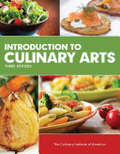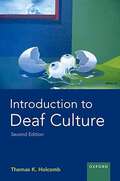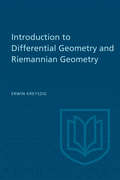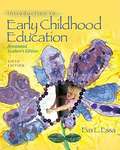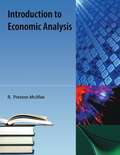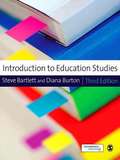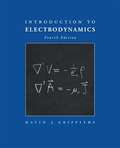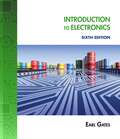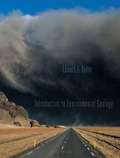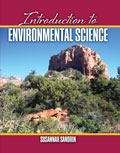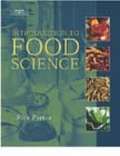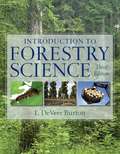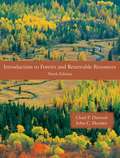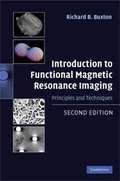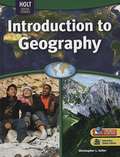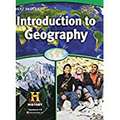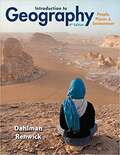- Table View
- List View
Introduction to Culinary Arts, Student Edition
by The Culinary Institute of AmericaNIMAC-sourced textbook <P><P>The Culinary Institute of America, a leader in culinary excellence for over 60 years, takes your high school students through a journey from a culinary arts student through employability. Introduction to Culinary Arts provides a solid foundation in culinary arts with a wealth of features that spotlight the important information. This powerful text also addresses culinary management and business skills.
Introduction to Deaf Culture (PROFESSIONAL PERSPECTIVES ON DEAFNESS: EVIDENCE AND APPLICATIONS)
by Thomas K. HolcombThomas K. Holcomb's highly successful textbook on Deaf culture has been fully revised and updated in this second edition. The changes reflect those in the field and include three new chapters focusing on the impact of technology on the Deaf experience, the roles of allies in supporting the Deaf community, and the diversity that exists in the Deaf community. Also new to this edition is an ASL summary of each chapter, making the book accessible in two languages that are important in the Deaf community, ASL and English. The book provides a broad yet in-depth exploration of how Deaf people are best understood from a cultural perspective. It explores the tension between the Deaf and disabled communities, the cultural norms of the Deaf community, Deaf art and literature, the solutions being offered by the medical and Deaf communities for effective living as Deaf individuals, and an analysis of the universality of the Deaf experience. As a member of a multigenerational Deaf family with a lifetime of experience living bi-culturally among Deaf and hearing people, author Thomas K. Holcomb enhances the academic discussions with engaging stories and the poetry and art of Deaf individuals. In addition to being used in college-level courses, this book can also help parents and educators of Deaf children understand the world of Deaf culture. It offers a beautiful introduction to the ways Deaf people effectively manage their lives in a world full of people who hear.
Introduction to Design
by Alan PipesFrom the author of Production for Graphic Designers 3e, this book provides an engaging introduction to the fundamentals of art and design. With a wide range of illustrations, Alan Pipes demonstrates in Part 1 (Elements) how an artist or designer fills a blank canvas, nothingness, with points, lines, shapes, textures, and colors in order to create a sense of space, time, and motion. Part 2 (Rules) reveals how to develop unity and harmony, balance, scale, and proportion, contrast and emphasis, and rhythm-all in the quest for a satisfying illusion. In addition, the author demonstrates his formidable knowledge of computer-aided art and design, supplementing it with his own color or black-white diagrams. This book is ideal for students embarking on courses in graphic design, fine art, and illustration-as well as allied courses in interior design, fashion design, textile design, industrial design, product design, and printmaking.
Introduction to Differential Geometry and Riemannian Geometry (Mathematical Expositions #16)
by Erwin KreyszigThis book provides an introduction to the differential geometry of curves and surfaces in three-dimensional Euclidean space and to n-dimensional Riemannian geometry. Based on Kreyszig's earlier book Differential Geometry, it is presented in a simple and understandable manner with many examples illustrating the ideas, methods, and results.<P><P> Among the topics covered are vector and tensor algebra, the theory of surfaces, the formulae of Weingarten and Gauss, geodesics, mappings of surfaces and their applications, and global problems. A thorough investigation of Reimannian manifolds is made, including the theory of hypersurfaces. <P> Interesting problems are provided and complete solutions are given at the end of the book together with a list of the more important formulae. Elementary calculus is the sole prerequisite for the understanding of this detailed and complete study in mathematics.
Introduction to Disability Studies
by David JohnstoneAn introductory text that explores the current issues in the lives and circumstances of disabled people, their careers, and those who intend to work in the caring services. Explores and analyzes quality of life factors, the emergence of rights, and the strengths and weakness of community care provisions. Also provides examples of individual oppressions and success stories, and suggests how disabled and non-disabled people can collaborate in the development of inclusive communities and neighborhoods. Distributed by Taylor & Francis. Annotation c. by Book News, Inc., Portland, OR.
Introduction to Early Childhood Education (6th Edition, Annotated Student’s Edition)
by Eva L. EssaThe book provides a comprehensive overview of early childhood education that is solidly based on current research and theories. The text, inter alia, examines curriculum and the fostering of creativity, as well as physical, cognitive, language, and social development--and every facet of early childhood education is examined and explained. This extensively revised edition includes new standards and accountability in the field of early childhood education.
Introduction to Econometrics: Principles and Applications (3rd Edition)
by Wallace E. Oates Harry H. KelejianIntroduction To Econometrics: Principles And Applications
Introduction to Economic Analysis
by R. Preston McafeeThis book presents introductory economics ("principles") material using standard mathematical tools, including calculus. It is designed for a relatively sophisticated undergraduate who has not taken a basic university course in economics. It also contains the standard intermediate microeconomics material and some material that ought to be standard but is not. The book can easily serve as an intermediate microeconomics text. The focus of this book is on the conceptual tools and not on fluff. Most microeconomics texts are mostly fluff and the fluff market is exceedingly over-served by $100+ texts. In contrast, this book reflects the approach actually adopted by the majority of economists for understanding economic activity. There are lots of models and equations and no pictures of economists.
Introduction to Economic Analysis
by R. Preston Mcafee Tracy R. LewisThis book presents standard intermediate microeconomics material and some material that, in the authors' view, ought to be standard but is not. Introductory economics material is integrated. Standard mathematical tools, including calculus, are used throughout. The book easily serves as an intermediate microeconomics text, and can be used for a relatively sophisticated undergraduate who has not taken a basic university course in economics. The focus of this book is on the conceptual tools and not on fluff. As such, it reflects the approach actually adopted by the majority of economists for understanding economic activity. There are lots of models and equations, and no pictures of economists ;-) Economic analysis is used in many situations. When British Petroleum sets the price for Alaskan crude oil, it uses an estimated demand model, both for gasoline consumers and also for the refineries to which BP sells. Economic analysis was used by experts in the antitrust suit brought by the U.S. Department of Justice both to understand Microsoft s incentive to foreclose (eliminate from the market) rival Netscape and consumer behavior in the face of alleged foreclosure. Stock market analysts use economic models to forecast the profits of companies to predict the price of their stocks. When the government forecasts the budget deficit or considers a change in environmental regulations, it uses economic models. This book presents the building blocks of the models in common use by an army of economists thousands of times per day. This book, plus econometrics, provides most of the economic analysis tools to take upper division economics courses of any type.
Introduction to Economic Analysis
by R. Preston Mcafee Tracy R. LewisThis book presents standard intermediate microeconomics material and some material that, in the authors' view, ought to be standard but is not. Introductory economics material is integrated. Standard mathematical tools, including calculus, are used throughout. The book easily serves as an intermediate microeconomics text, and can be used for a relatively sophisticated undergraduate who has not taken a basic university course in economics. The focus of this book is on the conceptual tools and not on fluff. As such, it reflects the approach actually adopted by the majority of economists for understanding economic activity. There are lots of models and equations, and no pictures of economists ;-) Economic analysis is used in many situations. When British Petroleum sets the price for Alaskan crude oil, it uses an estimated demand model, both for gasoline consumers and also for the refineries to which BP sells. Economic analysis was used by experts in the antitrust suit brought by the U.S. Department of Justice both to understand Microsoft s incentive to foreclose (eliminate from the market) rival Netscape and consumer behavior in the face of alleged foreclosure. Stock market analysts use economic models to forecast the profits of companies to predict the price of their stocks. When the government forecasts the budget deficit or considers a change in environmental regulations, it uses economic models. This book presents the building blocks of the models in common use by an army of economists thousands of times per day. This book, plus econometrics, provides most of the economic analysis tools to take upper division economics courses of any type.
Introduction to Education Studies
by Dr Steve Bartlett Dr Diana M BurtonEducation Studies is a broad, multi-disciplinary and rapidly growing field. Introduction to Education Studies has proven itself to be the key text for students of the subject for over a decade, leading readers through the field's key strands, concepts and applications without assuming any prior knowledge. <P><P> Bartlett and Burton provide first-time students and those engaged in more advanced aspects of the subject with all the tools that they need to approach Education Studies and also encourage a critical, questioning approach which will put them in good stead for further study and professional practice.<P> The new edition includes:<P> * A new chapter on globalisation and international comparative education <P> * A new companion website featuring online journal articles relating to each chapter <P> * More guidance on how to critique research <P> * More 'Reader Reflection' boxes, encouraging students to reflect on their own practice throughout <P> * A new framework for analysing policy <P> * New sections within the curriculum and the history of schooling chapters reflecting the latest UK developments<P> * Complete update of education policy issues <P> Additional online resources at www.uk.sagepub.com/bartlett3e<P> Also available are free journal articles accompanying each chapter of the book, enabling discussion and further reading to deepen students knowlege of each chapter subject.<P> Steve Bartlett is Professor of Education Studies at the University of Wolverhampton.<P> Diana Burton is Professor of Education and Pro Vice Chancellor at Liverpool John Moores University.
Introduction to Electrodynamics (4th Edition)
by David J. GriffithsFor junior/senior-level electricity and magnetism courses. This book is known for its clear, concise, and accessible coverage of standard topics in a logical and pedagogically sound order. The highly polished Fourth Edition features a clear, accessible treatment of the fundamentals of electromagnetic theory, providing a sound platform for the exploration of related applications (ac circuits, antennas, transmission lines, plasmas, optics, etc. ). Its lean and focused approach employs numerous new examples and problems.
Introduction to Engineering Analysis: Applying Algebra II to Solve Engineering Problems
by Edmund TsangIntroduction to Engineering Analysis: Applying Algebra II to Solve Engineering Problems
Introduction to Environmental Geology Fifth Edition
by Edward A. KellerThis text focuses on helping non-science majors develop an understanding of how geology and humanity interact. Ed Keller--the author who first defined the environmental geology curriculum--focuses on five fundamental concepts of environmental geology: Human Population Growth, Sustainability, Earth as a System, Hazardous Earth Processes, and Scientific Knowledge and Values. These concepts are introduced at the outset of the text, integrated throughout the text, and revisited at the end of each chapter. The Fifth Edition emphasizes currency, which is essential to this dynamic subject, and strengthens Keller's hallmark "Fundamental Concepts of Environmental Geology," unifying the text's diverse topics while applying the concepts to real-world examples.
Introduction to Environmental Science
by Susannah SandrinIntroduction To Environmental Science by Susannah Sandrin
Introduction to Food Science
by Rick Parker"Introduction to Food Science" provides an overview of the science of foods, from nutrition and digestion to processing and preservation. The material is based on a thorough, easy-to-follow outline that makes developing a lesson plan simple. Each chapter contains a list of learning objectives that help identify important concepts and key words that are essential to the understanding of the material. Tables, charts, graphs and illustrations are inserted throughout the text, providing quick and understandable access to information. The "student activities" section at the end of each chapter provide opportunities to directly apply material. The text also provides insight into career opportunities for those interested in working within food science industries.
Introduction to Forestry Science
by L. Devere BurtonPractical, easy to understand, and up-to-date, INTRODUCTION TO FORESTRY SCIENCE, Third Edition provides readers with a comprehensive overview of the principles and practices of forest management that are commonly practiced in the United States. Appropriate for anyone interested in forestry or natural resources, this book is filled with visual aids and tools as well as career profiles which give readers an overview of what it might be like to work in the forest industry and demonstrate how concepts are applied in the real world. In addition to covering the basics of the biological processes necessary for the creation of forests, topics such as the economic impact of forests on the U. S. economy, government historical events and policies, regional differences in forests and forest management, and laws and regulations that govern the use of forests are presented.
Introduction to Forests and Renewable Resources
by John C. Hendee Chad P. DawsonThe introductory course in natural resources is broader and more diverse than ever. Today's students need to know how to manage forest, wildlife, watershed, and range resources in a variety of environments and serving the needs of myriad stakeholders. To that end, Chad Dawson has built on the foundation established by him and the late John Hendee to bring Introduction to Forests and Renewable Resources thoroughly up to date. The Ninth Edition has been reorganized to better address content-for example, policy and the differences between managing federal, state, and private land--that applies to all resources. While forests continue to be emphasized, more coverage is provided to other resources and to achieving management goals for multiple resources when considering topics like fire and recreation.
Introduction to Formal Logic With Philosophical Applications
by Russell MarcusRigorous yet engaging and accessible, Introduction to Formal Logic with Philosophical Applications is composed of two parts. The first part (Chapters 1-5) provides a focused, "nuts-and-bolts" introduction to formal deductive logic that covers syntax, semantics, translation, and natural deduction for propositional and predicate logics. The second part (Chapters 6-7) presents stand-alone, student-friendly essays on logic and its application in philosophy and beyond, with writing prompts and suggestions for further readings.
Introduction to Functional Magnetic Resonance Imaging
by Richard B. BuxtonFunctional Magnetic Resonance Imaging (fMRI) has become a standard tool for mapping the working brain's activation patterns, both in health and in disease. It is an interdisciplinary field and crosses the borders of neuroscience, psychology, psychiatry, radiology, mathematics, physics and engineering. Developments in techniques, procedures and our understanding of this field are expanding rapidly. In this second edition of Introduction to Functional Magnetic Resonance Imaging, Richard Buxton - a leading authority on fMRI - provides an invaluable guide to how fMRI works, from introducing the basic ideas and principles to the underlying physics and physiology. He covers the relationship between fMRI and other imaging techniques and includes a guide to the statistical analysis of fMRI data. This book will be useful both to the experienced radiographer, and the clinician or researcher with no previous knowledge of the technology.
Introduction to Geography: People, Places and Environment
by Carl Dahlman William RenwickIntroduction to Geography: People, Places, & Environment, Sixth Edition introduces the major tools, techniques, and methodological approaches of the discipline through new applied visual features that engage students and reinforce real-world connections. <P><P> The authors emphasize the integration of various aspects of geographic processes and systems by discussing what happens in one set of geographic processes and how that affects others. For example, what happens in economic systems affects environmental conditions; what happens to climate affects political dynamics. The Sixth Edition has been tightly integrated with MasteringGeography™, Pearson’s online homework, tutorial, and assessment product designed to improve results by helping students quickly master concepts.

